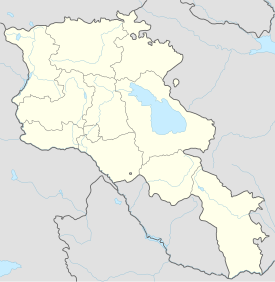Sardarabad (fortress)
| Sardar's Fortress Սարդարի բերդ | |
|---|---|
| Armavir Province, Armenia | |
| File:Gagarin kurdsandtatars.JPG Trick Riding of Kurds and Tatars in front of the Fortress Sardarabad (Sardari Berd) in Armenia, a mid-19th century painting by the Russian artist Grigory Gagarin, who was there as a soldier. | |
| Type | Fortress |
| Site information | |
| Controlled by | Before its capture, the Persian Qajar governors of the Erivan Khanate. |
| Open to the public | Yes |
| Condition | Very little of the fortress survives; Stones were used to build Soviet Armenia. |
| Site history | |
| Built | Between 1807-1828 |
| Built by | Sardar Hosein Qoli Khan |
| In use | As a fortification, as administrative center for the Sardarapat district and as a summer residence of the Khan of Yerevan. |
| Materials | Stone; Some stones used from the ancient city of Armavir. |
| Demolished | Yes |
| Battles/wars | Captured by the Russians under General Ivan Paskevich in 1828. |
Sardari Berd (Armenian: Սարդարի Բերդ: deriven from Sardar Persian: سردار; a title of Persian origin, used for military or political leaders meaning "commander" or "chieftain" and Berd Armenian: Բերդ; meaning "fortress".) sits on the right before the cemetery in the village of Hoktember in the Armavir Province of Armenia. It is actually historically associated with the city of Armavir which was then known prior to 1932 as Sardarabad or Sardarapat.
History
The fortress was built sometime between the years of 1807-1828, during the rule and with the assistance of Sardar Hosein Qoli Khan Qajar (Sardari Iravani), the last and best of the Persian Qajar governors of the Yerevan Khanate. It was constructed using stones taken from the ruins of the ancient city of Armavir, some of which still bear traces of Urartian cuneiform inscriptions. The fortress was used as an administrative center for the Sardarapat district and also as the summer residence of the Khan of Yerevan (Erevan).
Sardari Berd was captured in 1828 by the Russians under General Ivan Paskevich during the Russo-Persian War (1826-1828), despite strong defense by Hasan Khan Sardari Iravani, brother to Sardar Hosein Qoli Khan. Speaking of Paskevich in a British War Office summary, the following passage reads:
"Sardarabad, a large fortified village on a canal fed by the Arax, was next taken, and the stock of provisions found in it placed Paskevich in a position to commence the siege of Yerevan."
The region formally passed from Persian sovereignty to a Russian one after the Treaty of Turkmenchay in 1828. Armavir became the Serdarabad uyezd of the Armenian Oblast, which itself became the Erivan guberniya in 1840. This situation lasted until the February Revolution in 1917. Of the fortress almost nothing remains. Most of it was dismantled to build Soviet Armenia.
References
- Kiesling, Brady (2005), Rediscovering Armenia: Guide, Yerevan, Armenia: Matit Graphic Design Studio
- Kiesling, Brady (June 2000). Rediscovering Armenia: An Archaeological/Touristic Gazetteer and Map Set for the Historical Monuments of Armenia (PDF). Archived (PDF) from the original on 6 November 2021.
See also
- Armavir, Armenia
- Hoktember, Armenia
- Sardarapat Memorial, commemorating the Battle of May 22–26, 1918.

